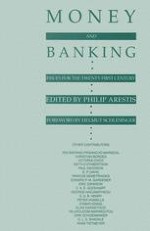1993 | OriginalPaper | Chapter
UK Monetary Aggregates — Definition and Control
Authors : P. Arestis, I. Biefang-Frisancho Mariscal, P. G. A. Howells
Published in: Money and Banking
Publisher: Palgrave Macmillan UK
Included in: Professional Book Archive
Activate our intelligent search to find suitable subject content or patents.
Select sections of text to find matching patents with Artificial Intelligence. powered by
Select sections of text to find additional relevant content using AI-assisted search. powered by
During the 1980s, UK governments, in common with many others, adopted a formal commitment to target growth rates for selected monetary aggregates. For the UK, however, the novelty lay largely in the formality of the policy and the consequent publicity given to target rates of growth, since de facto targeting had first appeared many years earlier, forced upon Labour governments in 1968–9 and again in 1976. By 1985, however, evidence about the declining significance of monetary growth (in the form of a sharp fall in velocity) combined with evidence about the authorities’ inability anyway to control the aggregates and monetary targeting acquired a lower profile in the second half of the 1980s as attention was switched to the exchange rate. In 1988 the episode of ‘shadowing the deutschmark’ led to a very rapid increase in money supply which was later blamed by many for the inflationary boom of 1989–90. The result, as we enter the 1990s, is a revival of interest in strict monetary control and in the methods by which it may be achieved. The central message of this chapter is that whatever methods might be adopted, recent changes in the institutional structure rule out a return to the interest rate methods of the last twenty years.
